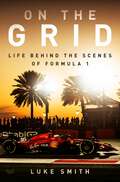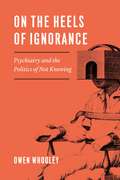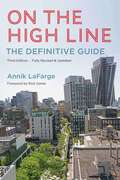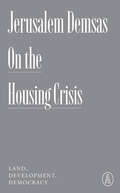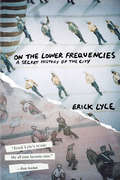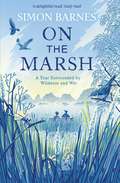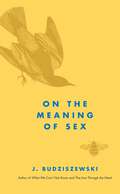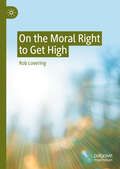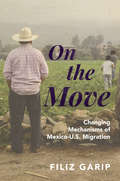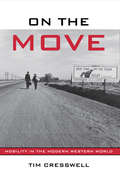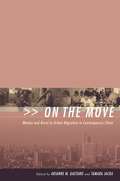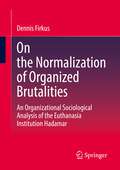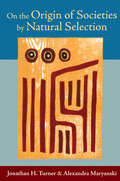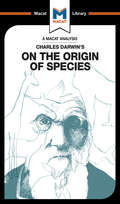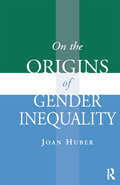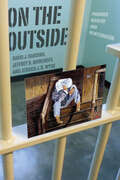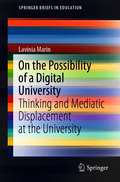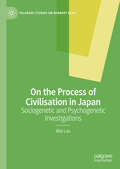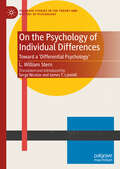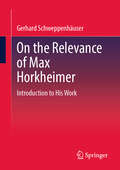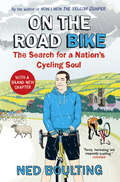- Table View
- List View
On the Grid: Life Behind the Scenes of Formula 1
by Luke Smith“One of the finest wordsmiths in modern sport . . . with infectious passion and singular craft [Smith] has created a truly fabulous and unique piece of work. On the Grid is incredibly special. I loved every thoughtfully written word.” —Will Buxton, award-winning broadcaster, star of Drive to Survive and New York Times bestselling author of Grand Prix: An Illustrated History of Formula 1“Even if you think you know everything there is to know about Formula 1, you'll learn something within these pages.” —GP Racing MagazineLearn how Formula One is the world’s greatest team sport with this intimate and colorful insider’s account of what really happens on—and off—the race track, from The Athletic’s senior F1 writer who has been following the sport around the world for over a decade.Formula One has only 20 drivers in its elite ranks, but behind each one is an army of professionals devoted to the sport: statisticians and strategists, engineers and mechanics, PR gurus and party planners, and more—all who spend months traveling thousands of miles across the globe each year. Their achievements (and failures) may not be as well-publicized as those of the drivers and team principals, but they’re just as important: one fifty-cent screw in the wrong place could cause a $15 million car to break down mid-race.In On the Grid, F1 journalist Luke Smith brings to life the behind-the-scenes stories that don’t make it to viewers’ screens. From the Bahrain starting grid—thick with sweat and engine fumes—to opulent yacht parties in Monaco, with a stopover at a legendary bakery in Melbourne whose croissants exist only because of F1 technology, he showcases the extraordinary characters who give the sport such color and intrigue. With deep insight, knowledge, and warmth, he writes about the emotions and struggles that come with working in such a high-pressure and inherently dangerous sport, and the efforts being made to improve its class and racial diversity, gender parity, and environmental impact. The result is a richer, broader, and more inclusive look at F1 than ever before—perfect for longtime fans and Drive to Survive neophytes alike.
On the Ground After September 11: Mental Health Responses and Practical Knowledge Gained
by Yael Danieli Robert L DingmanA heartfelt collection of extraordinary first-person accounts that delve into every level of the experience of 9/11Out of the infamy of 9/11 and its aftermath people rose up with courage and determination to meet formidable challenges. On the Ground After September 11: Mental Health Responses and Practical Lessons Gained is a stirring compilation of over a hundred personal and professional first-hand accounts of the entire experience, from the moment the first plane slammed into the North Tower of the World Trade Center, to the months mental health professionals worked to ease the pain and trauma of others even while they themselves were traumatized. This remarkable chronicle reveals the breadth and depth of human need and courage along with the practical organizational considerations encountered in the responses to terrorist attacks. The goal of any terrorist act is to instill psychosocial damage to a society to effect change. On the Ground After September 11 provides deep insight into the damage the attack had on our own society, the failures and victories within our response systems, and the path of healing that mental health workers need to travel to be of service to their clients. Personal accounts written by the professionals and public figures involved reveal the broad range of responses to this traumatic event and illuminate how mental health services can most effectively be delivered. Through the benefit of hindsight, recommendations are described for ways to better finance assistance, adapt the training of mental health professionals, and modify organizations&’ response to the needs of victims in this type of event. Reading these unique personal accounts of that day and the difficult days that followed provides a thoughtful, moving, rational view of what is truly needed in times of disaster.On the Ground After September 11 includes the first-person experiences and lessons learned from the people of: NYU Downtown Hospital NYC Department of Health and Mental Hygiene NY Metropolitan Transportation Council St. Paul&’s Chapel St. Vincent Hospital - Manhattan Safe Horizon LifeNet WTC Incident Command Center at NYC Medical Examiner&’s office New Jersey&’s Project Phoenix Massachusetts Department of Mental Health the military psychiatric response to the Pentagon attack Connecticut&’s Center for Trauma Response, Recovery, and Preparedness the Staten Island Relief Center Barrier Free Living Inc. for people with disabilities the Federal Emergency Management Agency Alianza Dominicana, Inc. Staten Island Mental Health Society the United Airlines Emergency Response Team for Flight 93 The Center for Trauma Response, Recovery, and Preparedness (CTRP) Disaster Mental Health Services (DMHS) at Dulles International Airport the American Red Cross the Respite Center at the Great White Tent HealthCare Chaplaincy The Salvation Army the Islamic Circle of North America The Coalition of Voluntary Mental Health Agencies, Inc. F*E*G*S the Jewish Board of Family and Children's Services (JBFCS) and many, many moreOn the Ground After September 11: Mental Health Responses and Practical Lessons Gained poignantly illustrates that regardless of profession, culture, religion, or age, every life touched by 9/11 will never be the same. This is essential reading for counselors, psychologists, psychiatrists, social workers, therapists, trauma specialists, educators, and students.
On the Heels of Ignorance: Psychiatry and the Politics of Not Knowing
by Owen WhooleyPsychiatry has always aimed to peer deep into the human mind, daring to cast light on its darkest corners and untangle its thorniest knots, often invoking the latest medical science in doing so. But, as Owen Whooley’s sweeping new book tells us, the history of American psychiatry is really a record of ignorance. On the Heels of Ignorance begins with psychiatry’s formal inception in the 1840s and moves through two centuries of constant struggle simply to define and redefine mental illness, to say nothing of the best way to treat it. Whooley’s book is no antipsychiatric screed, however; instead, he reveals a field that has muddled through periodic reinventions and conflicting agendas of curiosity, compassion, and professional striving. On the Heels of Ignorance draws from intellectual history and the sociology of professions to portray an ongoing human effort to make sense of complex mental phenomena using an imperfect set of tools, with sometimes tragic results.
On the High Line: The Definitive Guide
by Annik LaFargeThe most comprehensive, up-to-date, and acclaimed guide to the High Line by the leading expert on the history of the park—now in a fully revised editionBuilt atop a former freight railroad, the “park in the sky” is regularly cited as one of the premiere examples of adaptive reuse and quickly became one of New York’s most popular destinations, attracting more than 8 million visitors a year. This updated Third Edition of On the High Line— published to coincide with the fifteenth anniversary of the park’s opening—remains the definitive guide to the park that transformed an entire neighborhood and became an inspiration to cities around the globe.In short entries organized by roughly two city block sections, the guide provides rich details about everything in view on both sides of the park. Illustrated with more than 110 black & white photographs, it covers historic and modern architecture; plants and horticulture; and important industries and technological innovations that developed in the neighborhoods the park traverses, from book publishing and food distribution to the introduction of cold storage and the development of radar, the elevator, and talking movies. Updated to include newly opened sections of the park, this edition also features a new conversation pertaining to the more controversial side of the High Line’s story and how it became a poster child for the most grievous manifestations of gentrification and inequity in public spaces. Author Annik LaFarge provides a frank discussion on how the park’s leadership created a platform for discussing these issues and for advising other projects on how to work more inclusively and from a social justice and equity perspective.On the High Line serves as an educated travel companion, someone invisibly perched on a visitor’s shoulder who can answer every question, including what was here before, moving back in time through the early 20th century, the Industrial Revolution, and the colonial and pre-European times when this stretch of what we call Manhattan was home to the Lenape people and much of it was covered by the waters of the Hudson River. A companion website with more than 650 photos—historic, contemporary, rooftop and aerial—can be viewed at HighLineBook.com.
On the Housing Crisis: Land, Development, Democracy (Atlantic Editions)
by Jerusalem DemsasA rigorously reported anthology on how local politics have fueled a generation-defining national emergency. An Atlantic Edition, featuring long-form journalism by Atlantic writers, drawn from contemporary articles or classic storytelling from the magazine&’s 165-year archive.In this precise collection, Atlantic staff writer Jerusalem Demsas turns her authoritative expertise and keen eye to the housing shortage, one of our country&’s most dire yet widely misunderstood public frustrations. Demsas examines how local democracies have become coconspirators in the anti-development aspirations of the very few, at the hefty expense of the many. These essays identify the inefficiencies and irrationalities of contemporary land-use politics and the stages they play out on, offering readers a refreshing and accessible guide to a generational crisis.
On the Lower Frequencies
by Erick LyleOn the Lower Frequencies is at once a manual, memoir, and history of creative resistance in a world awash with war and poverty. An icon on the 1990s zine scene, Iggy Scam traces not only the evolution of cities, but of his own thinking, from his early focus on more outré forms of resistance through more contemplative times as he becomes preoccupied with the need for a more affirmative vision of the future. In one of the book’s key pieces, Scam celebrates the history and passing of Hunt’s Donuts in San Francisco’s Mission District. On one level an epitaph for a beloved hangout and on another a metaphor for the effects of gentrification, it’s the untold history of an entire neighborhood in a single retail establishment. Whether handing out fake Starbucks coupons or dreaming of a future with more public art and punk holidays, Scam gives the reader inspiration for living defiantly.
On the Marsh: A Year Surrounded by Wildness and Wet
by Simon BarnesHow the rewilding of eight acres of Norfolk marshland inspired a family and brought nature even closer to home. When writer Simon Barnes heard a Cetti's warbler sing out as he turned up to look at a house for sale, he knew immediately that he had found his new home. The fact that his garden backed onto an area of marshy land only increased the possibilities, but there was always the fear that it might end up in the wrong hands and be lost to development or intensive farming. His wife saw through the delicate negotiations for the purchase. Once they'd bought it, they began to manage it as a conservation area, working with the Wildlife Trust to ensure it became as appealing as possible to all species. For their son Eddie, who has Down's syndrome, it became a place of calm and inspiration. In On The Marsh, we see how nature can always bring surprises, and share in the triumphs as new animals - Chinese water deer, otters and hedgehogs - arrive, and watch as the number of species of bird tops 100 and keeps on growing. As the seasons go by, there are moments of triumph when not one but two marsh harrier families use the marsh as a hunting ground, but also disappointments as chemical run-off from neighbouring farmland creates a nettles monoculture in newly turned earth. For anyone who enjoyed books such as Meadowland, or the writing of Stephen Moss, Roger Deakin or Adam Nicolson, this is a vivid and beautifully written account of the wonders that can sometimes be found on our doorsteps, and how nature can transform us all.
On the Meaning of Sex
by J. BudziszewskiOur society is obsessed with sex - and yet we don't understand it at all. Acclaimed philosopher J. Budziszewski remedies the problem in this wise, gracefully written book about the nature, meaning, and mysteries of sexuality. On the Meaning of Sex corrects the most prevalent errors about sex - particularly those of the sexual revolution, which by mistaking pleasure for a good in itself has caused untold pain and suffering.
On the Moral Right to Get High
by Rob LoveringIs getting high immoral? In this book, Rob Lovering defends the claim that it is not. More specifically, he argues that recreational drug use (of which getting high is a token) is neither intrinsically, nor generally extrinsically, immoral. In other words, he contends that recreational drug use is neither immoral in and of itself nor generally immoral due to an immoral-making factor with which it may be contingently linked [e.g., harm]. Lovering does so by offering two arguments for recreational drug use&’s ultima facie (all things considered) moral permissibility and critiquing twenty-four arguments for its immorality.Meant to be a companion to Lovering's A Moral Defense of Recreational Drug Use (Palgrave Macmillan, 2015), which was written for a general audience, this book is written for an academic—specifically, philosophical—audience and explores recreational drug use in a deeper, more philosophically and empirically rigorous way.
On the Move: Changing Mechanisms of Mexico-U.S. Migration
by Filiz GaripWhy do Mexicans migrate to the United States? Is there a typical Mexican migrant? Beginning in the 1970s, survey data indicated that the average migrant was a young, unmarried man who was poor, undereducated, and in search of better employment opportunities. This is the general view that most Americans still hold of immigrants from Mexico. On the Move argues that not only does this view of Mexican migrants reinforce the stereotype of their undesirability, but it also fails to capture the true diversity of migrants from Mexico and their evolving migration patterns over time.Using survey data from over 145,000 Mexicans and in-depth interviews with nearly 140 Mexicans, Filiz Garip reveals a more accurate picture of Mexico-U.S migration. In the last fifty years there have been four primary waves: a male-dominated migration from rural areas in the 1960s and '70s, a second migration of young men from socioeconomically more well-off families during the 1980s, a migration of women joining spouses already in the United States in the late 1980s and '90s, and a generation of more educated, urban migrants in the late 1990s and early 2000s. For each of these four stages, Garip examines the changing variety of reasons for why people migrate and migrants' perceptions of their opportunities in Mexico and the United States. Looking at Mexico-U.S. migration during the last half century, On the Move uncovers the vast mechanisms underlying the flow of people moving between nations.
On the Move: Mobility in the Modern Western World
by Timothy CresswellOn the Move presents a rich history of one of the key concepts of modern life: mobility. Increasing mobility has been a constant throughout the modern era, evident in mass car ownership, plane travel, and the rise of the Internet. Typically, people have equated increasing mobility with increasing freedom. However, as Cresswell shows, while mobility has certainly increased in modern times, attempts to control and restrict mobility are just as characteristic of modernity. Through a series of fascinating historical episodes Cresswell shows how mobility and its regulation have been central to the experience of modernity.
On the Move: Women and Rural-to-Urban Migration in Contemporary China
by Tamara Jacka Arianne M. GaetanoThis book explores the impact of migration on the identities, values, worldviews, and social positions of migrant women in contemporary China based on original fieldwork as well as in-depth research in multiple regions of China.
On the Nature of Human Resource Development: Holistic Agency and an Almost-Autoethnographical Exploration of Becoming (Routledge Studies in Human Resource Development)
by Monica LeeThe nature of human resource development (HRD) has been, and remains, a contested topic – the debate was sparked in part by Monica Lee’s seminal 2001 paper which refused to define the discipline of HRD, but has been accentuated by increasing globalization, political unrest, inequality and the erosion of boundaries. Should HRD now be seen as more than ‘training,’ or a sub-function of large western bureaucracy? This book represents a very wide view of HRD: that it is at the core of our ‘selves’ and our relationships, and that we continually co-create ourselves, our organisations and societies. These ideas are hung upon a model of Holistic Agency, and supported from sources as diverse as evolutionary psychology, science fiction, the challenges of transitional economies, and the structural uncertainties of contemporary society. Examining the tensions between self and other, agency and structure, the book draws inspiration from an almost-autoethnographic approach. This yields a text that is personal, entertaining, and easier to read than many academic tomes – yet considers the depth and development of the human condition, and locates HRD within that.
On the Nature of Human Sexual Difference: A Symposium (Historical-Analytical Studies on Nature, Mind and Action #15)
by Timothy Paul FortinThis work offers a “symposium” on the nature of human sexual difference drawing on Plato’s masterpiece: having explored the observed phenomena of sexual difference, four stories are told of the origins, essence, and ends of the human male and female. First, the evolutionists, and then Simone de Beauvoir, and Judith Butler present their accounts. Next, a fourth (and unique vision for our age) is added: the thought of Thomas Aquinas is placed in dialogue with the evolutionists, Beauvoir, and Butler, thereby introducing into contemporary discourse a voice that is both ancient and new. The work seeks to trace each protagonist’s account to its fonts, so providing a perspective from which various streams of thought might be understood both in their divergence and common origins. It thus hopes to offer a common language and an interpretive key in a realm where confusion and misunderstanding too often reign.
On the Normalization of Organized Brutalities: An Organizational Sociological Analysis of the Euthanasia Institution Hadamar
by Dennis FirkusThis book takes an organizational sociological perspective on the systematically carried out mass murders in the context of Nazi euthanasia in Hadamar. On the basis of numerous theoretically elaborated as well as empirically proven organizational mechanisms, it is shown how these illegal practices were "normalized" in an extraordinary way by and for the personnel, who were not trained or otherwise predisposed to murder. The acts thus became a legitimate expectation of action, while at the same time the organizational integration had a desolidarizing, demoralizing, and responsibility-relieving effect.This book is a translation of an original German edition. The translation was done with the help of artificial intelligence (machine translation by the service DeepL.com). A subsequent human revision was done primarily in terms of content, so that the book will read stylistically differently from a conventional translation.
On the Origin of Societies by Natural Selection
by Jonathan H. Turner Alexandra MaryanskiKinship, religion, and economy were not "natural" to humans, nor to species of apes that had to survive on the African savanna. Society from its very beginnings involved an uneasy necessity that often stood in conflict with humans' ape ancestry; these tensions only grew along with later, more complex-eventually colossal-sociocultural systems. The ape in us was not extinguished, nor obviated, by culture; indeed, our ancestry continues to place pressures on individuals and their sociocultural creations. Not just an exercise in history, this pathbreaking book dispels many myths about the beginning of society to gain new understandings of the many pressures on societies today.
On the Origin of Species
by Kathleen Bryson Nadezda Josephine MsindaiCharles Darwin called on a broad and unusually powerful combination of critical thinking skills to create his wide-ranging explanation for biological change, On the Origin of Species. It’s one of those rare books that takes a huge problem – the enormous diversity of different species – and seeks to use a vast range of evidence to solve it. But it was perhaps Darwin’s towering creative prowess that made the most telling contribution to this masterpiece, for it was this that enabled him to make the necessary fresh connections between so much disparate evidence from such a diversity of fields. All of Darwin’s critical thinking skills were required, however, in the course of the decades of work that went into this volume. Taken as a whole, Darwin’s solution to the problem that he set himself is carefully researched, considers multiple explanations, and justifies its conclusions with well-organised reasoning. At the time of the publication, in 1859, there were various explanations for the changes that Darwin – and others – observed; what separated Darwin from so many of his contemporaries is that he deployed critical thinking to arrive at a significantly new way of fitting explanation to evidence; one that remains elegant, complete and predictive to this day.
On the Origins of Gender Inequality
by Joan HuberIn our fast-paced world of technology and conveniences, the biological origins of women's inequality can be forgotten. This book offers a richer understanding of gender inequality by explaining a key cause-women's reproductive and lactation patterns. Until about 1900, infants nursed every fifteen minutes on average for two years because very frequent suckling prevented pregnancy. The practice evolved because it maximized infant survival. If a forager child was born before its older sibling could take part in the daily food search, the older one died. This practice persisted until the modern era because until after the discovery of the germ theory of disease, human milk was the only food certain to be unspoiled. Lactation patterns excluded women from the activities that led to political leadership. During the twentieth century the ancient mode declined and women entered the labor market en masse. Joan Huber challenges feminists toward a richer understanding of biological origins of inequality-knowledge that can help women achieve greater equality today.
On the Outside: Prisoner Reentry and Reintegration
by David J. Harding Jeffrey D. Morenoff Jessica J. Wyse“A crucial analysis of how the truly disadvantaged people who enter prison fare in the three years after their release.” —Paula England, NYUAmerica’s high incarceration rates are a well-known facet of contemporary political conversations. Mentioned far less often is what happens to the nearly 700,000 former prisoners who rejoin society each year. On the Outside examines the lives of twenty-two people—varied in race and gender but united by their time in the criminal justice system—as they pass out of the prison gates and back into the world. The book takes a clear-eyed look at the challenges faced by formerly incarcerated citizens as they try to find work, housing, and stable communities. Standing alongside these individual portraits is a quantitative study conducted by the authors that followed every state prisoner in Michigan who was released on parole in 2003 (roughly 11,000 individuals) for the next seven years, providing a comprehensive view of their post-prison neighborhoods, families, employment, and contact with the parole system. On the Outside delivers a powerful combination of hard data and personal narrative that shows why our country continues to struggle with the social and economic reintegration of the formerly incarcerated.One of the Vera Institute of Justice’s Best Criminal Justice Books of 2019
On the Perception of Dynamic Emotional Expressions: A Cross-cultural Comparison
by Maria Teresa Teresa Riviello Anna EspositoThis work explores the power of visual and vocal channels, in conveying emotional cues exploiting realistic, dynamic and mutually related emotional vocal and facial stimuli, and aims to report on a cross cultural comparison on how people from different Western Countries perceive emotional dynamic stimuli. The authors attempt to give an answer to the following questions evaluating the subjective perception of emotional states in the single (either visual or auditory channel) and the combined channels: - In a body-to-body interaction, the addressee exploits both the verbal and non-verbal communication modes to infer the speaker's emotional state. Is such an informational content redundant? - Is the amount of information conveyed by each communication mode the same or is it different? - How much information about the speaker's emotional state is conveyed by each mode and is there a preferential communication mode for a given emotional state? -To what extent the cultural specificity affect the decoding of the emotional information? The results are interpreted in terms of cognitive load, language expertise and stimulus dynamics. This book will be of interest to researchers and scholars in the field of Human Computer Interaction, Affective Computing, Psychology, Social Sciences .
On the Possibility of a Digital University: Thinking and Mediatic Displacement at the University (SpringerBriefs in Education)
by Lavinia MarinThis book proposes a philosophical exploration of the educational role that media plays in university study practices, with a focus on the practices of lecturing and academic writing. Are the media employed in university study practices mere accessories, or rather constitutive of these practices? While this seems to be a purely theoretical question, its practical implications are wide and concern whether such a thing as a ‘digital university’ is possible. The 'digital university' has been, for a long time, a theoretical construct. However, in the aftermath of the Covid-19 pandemic, moving the university into the digital realm has become a necessity. The difficulties in transitioning to an online university during the 2020 pandemic showed the increased urgency of the questions explored in this book.The book describes lecturing and academic writing through the lens of a phenomenology of gestures and arrives at a description of the experience of university thinking as expanding the subject’s range of experiences about the world and about one’s modes of thinking about the world. The media configuration characteristic for university study practices is a movement of rendering inoperative one medium through another medium so that thinking can emerge, a movement called ‘mediatic displacement’. The question of the digital university becomes then a question whether mediatic displacement is possible on a digital screen. Although this is conceivable, digital technologies are still relatively new, and we are not used to playing with them in a profanatory way as the book discusses through the example of videoconferencing and MOOCs. The promise of the digital university seems to remain utopian until we figure out how to enact the techniques of mediatic displacement currently flourishing at the physical university.Both emerging and established researchers will benefit from this book since it offers an alternative way of discussing the possibility of a digital transformation of the university, starting from a phenomenology of gestures and an understanding of thinking as a collective experience of potentiality and profanation at the same time. By combining two perspectives, media-theoretical and educational-philosophical, this book show a new way of understanding what makes a university and, thus, contributes to the emerging debate on the digital university.
On the Process of Civilisation in Japan: Sociogenetic and Psychogenetic Investigations (Palgrave Studies on Norbert Elias)
by Wai LauThis book charts the process of civilisation in Japan. Using the theory of civilising processes developed by Norbert Elias, the author examines the complex underlying structural and psychological processes from the seventh century to the twentieth century. Furthermore, by drawing on rich historical data, the author illustrates how these complex processes led the Japanese to see themselves as ‘more civilised’ than their forebears and neighbouring countries. Although the theory serves as an important reference point, the author draws on other works to address different complex questions surrounding Japanese development. Therefore, this book presents three key themes: first, it gives an alternative understanding of the complex developments of Japanese society; second, it intercedes into an ongoing debate about the applicability of Elias’s theory in a non-Western context; and third, it expands Elias’s theory.
On the Psychology of Individual Differences: Toward a 'Differential Psychology' (Palgrave Studies in the Theory and History of Psychology)
by L. William SternThis book presents an English translation, by Nicolas and Lamiell, of the entirety of a German-language text authored by William Stern (1871-1938) and published in 1900. Its publication is widely considered to mark the founding of that sub-discipline of psychology devoted to the systematic study of individual and group differences. The book includes an introductory chapter by Nicolas and Lamiell, placing Stern's work into historical context and discussing its influence on the work of scholars who followed.By making this available for the first time for an Anglophone audience, it fills a significant gap in the history of psychology literature and offers a springboard into much needed critical discourse on the contemporary state of psychological testing in particular, and on the study of individual and group differences more broadly. It holds fresh insights for those specializing in the fields of personality psychology, educational psychology, and industrial-organizational psychology; as well as to practitioners in the fields of personal and educational counseling.
On the Relevance of Max Horkheimer: Introduction to His Work
by Gerhard SchweppenhäuserThe book provides a comprehensive and knowledgeable introduction to the work of Max Horkheimer and contributes to the updating of his theoretical approaches.
On the Road Bike: The Search For a Nation’s Cycling Soul
by Ned Boulting‘British cyclist. It used to be an oxymoron, a sort of silliness. Like French Cricket’ Ned Boulting has noticed something. It’s to do with bikes. They’re everywhere. And so are their riders. Some of these riders seem to be sporting sideburns and a few of them are winning things. Big things. Now Ned wants to know how on earth it came to this. And what, exactly is 'this'. In On the Road Bike, Ned Boulting asks how Britain became so obsessed with cycling. His journey takes him from the velodrome at Herne Hill to the Tour of Britain at Stoke-on-Trent via Bradley Wiggins, Chris Boardman, David Millar (and David’s mum), Ken Livingstone, both Tommy Godwins, Gary Kemp (yes, him from Spandau Ballet) and many, many more. The result is an amusing and personal exploration of the austere, nutty soul of British cycling.'Funny, fascinating and frequently touching ... will be enjoyed by anyone with even a passing interest in cycling. No bib shorts required' Guardian
